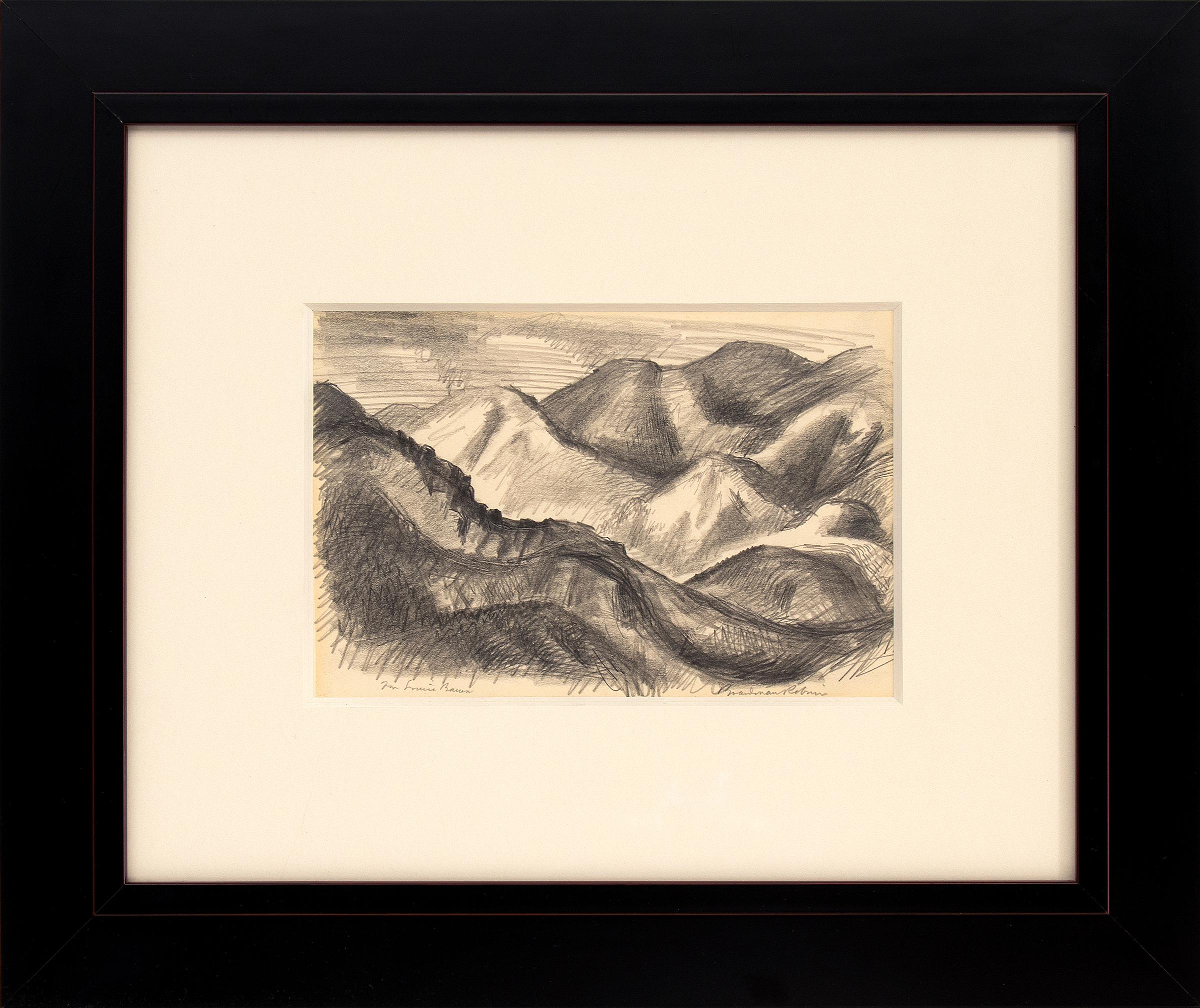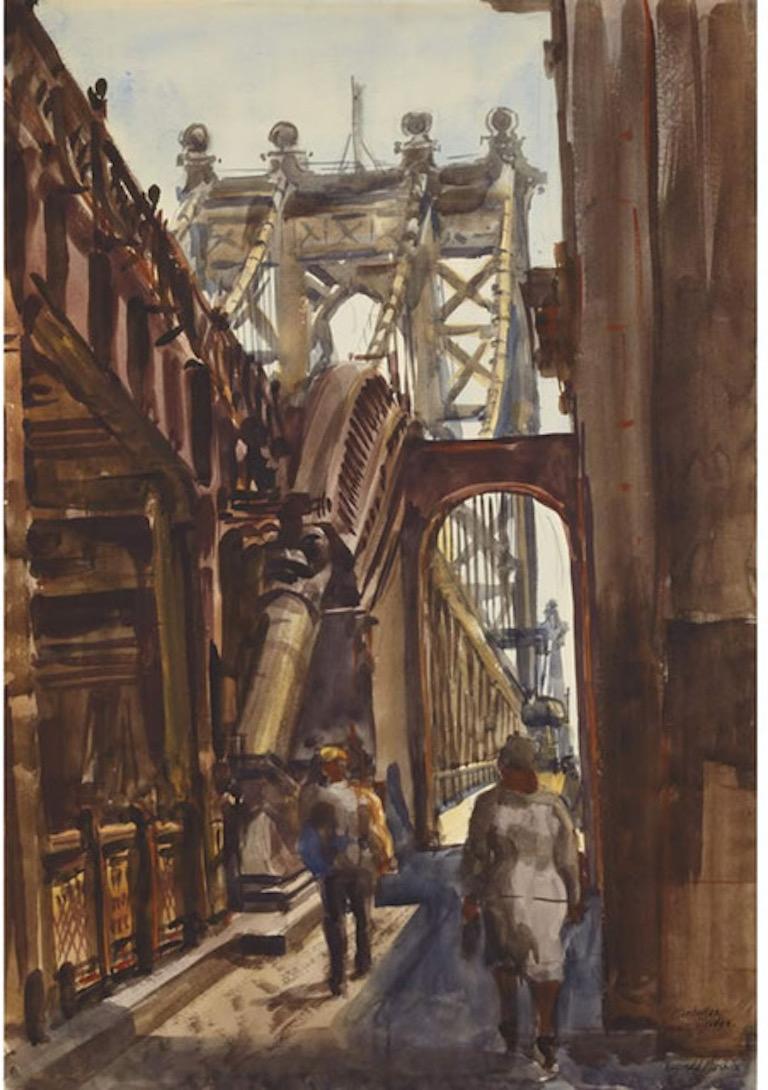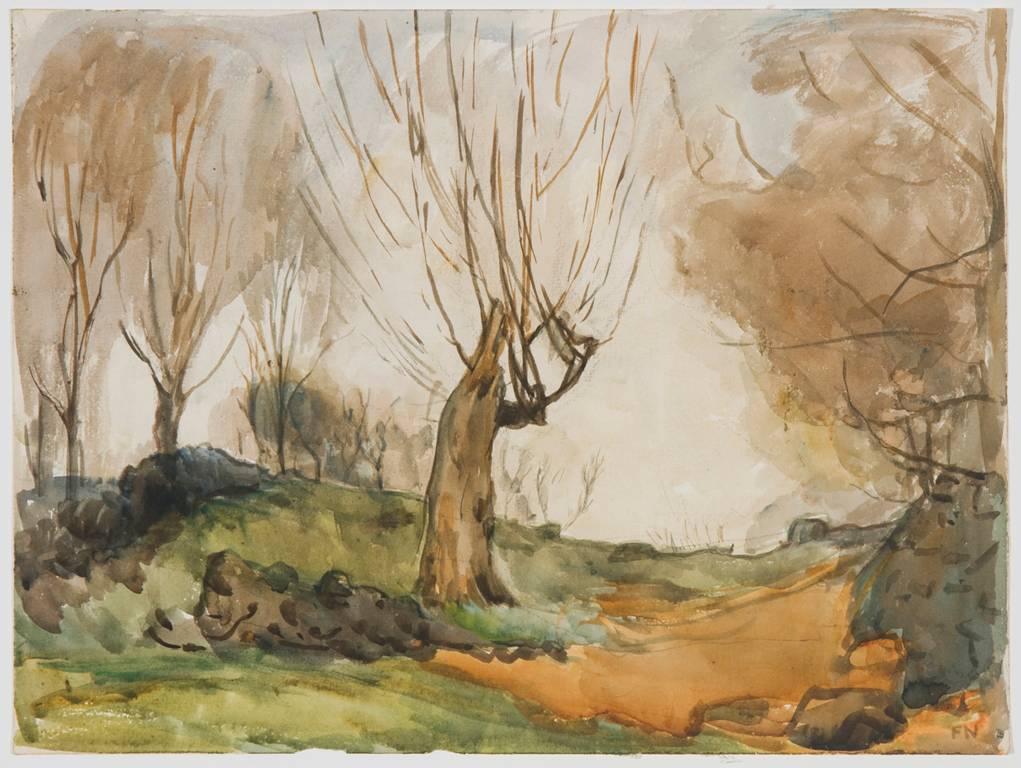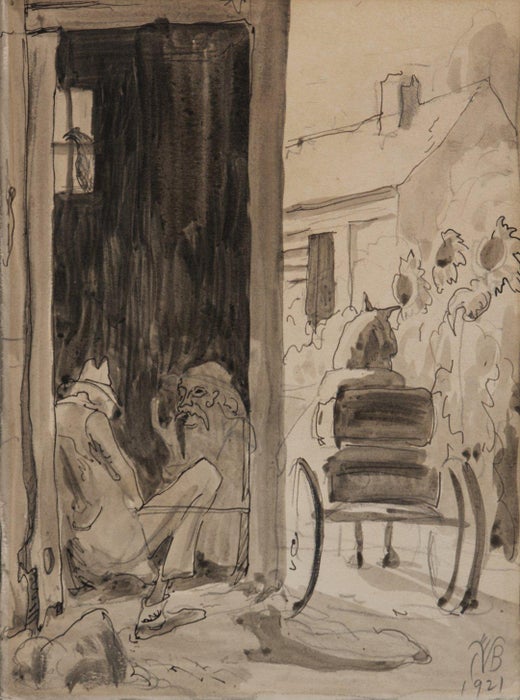Charles E. BurchfieldCharles Burchfield Preparatory Sketch, Early 20th CenturyEarly 20th Century
Early 20th Century
About the Item
- Creator:Charles E. Burchfield (1893-1967, American)
- Creation Year:Early 20th Century
- Dimensions:Height: 12.25 in (31.12 cm)Width: 18.75 in (47.63 cm)
- Medium:
- Movement & Style:
- Period:
- Condition:Very fragile paper with some loss and tears.
- Gallery Location:Larchmont, NY
- Reference Number:1stDibs: LU2211212049732
Charles E. Burchfield
Born in Ashtabula Harbor, Ohio, Charles Burchfield became known as a town-landscape painter of middle-western America, and his paintings, drawings and prints have had much influence on succeeding generations of artists. He has also been described as a social critic, naturalist, and transcendental visionary whose sensitivities infuse his artwork. Of his impact on American art, Matthew Baigell wrote: "Few American artists have ever responded with such passion to the landscape or have made it such a compelling repository as well as mirror of their intimate feelings."
In addition to his painting, Burchfield was a teacher at the Art Institute of Buffalo from 1949 to 1952 and at the University of Buffalo from 1950 to 1952.
Burchfield's career can be divided into three phases. The first is landscapes based on childhood memories and fantasies and ended about 1918; the second, from 1918 to 1943, is Social Realism, including “grimy streets and rundown buildings of the eastern Ohio area,” and the third phase is a return to subject matter of his childhood and the “investing them with a kind of ecstatic poetry.” (Biagell 54)
Throughout Burchfield's career, watercolor was his preferred medium. Knowledge of Oriental art influenced him to use simple forms.
Burchfield spent his youth in Salem, Ohio, where he developed a keen interest in art and nature and was intensely aware of woodland sounds and noises. In 1912, he decided to become a painter and enrolled in the Cleveland School of Art, where his most influential teacher was Henry Keller. Another major Ohio influence on his painting was William Sommer, leader of the modernist movement in the Cleveland area. He introduced Burchfield to experimental watercolor techniques and color theory, and Burchfield began attending sessions of the Kokoon Club, organized by Sommer and William Zorach to promote avant-garde art. In 1917, he developed a shorthand of abstractions of various shapes and moods, and he also began painting small houses that appeared to be haunted.
Burchfield served in World War I from 1918 to 1919, and served as sergeant in the Camouflage Corps, camouflaging artillery pieces. In 1921, he moved to Buffalo, New York, where until 1929, he worked as a wallpaper designer for the M.H. Birge and Sons Wallpaper Company. From that time, living the remainder of his life in Buffalo, he devoted himself full time to fine-art painting that ranged from rather sentimental depictions to abstraction in the 1960s.
In the 1920s, Burchfield moved away from what he perceived as an overactive imagination and did studies of architecture of Midwestern streets. This subject matter of the realities of the man-made world was influenced by his reading of Winesburg, Ohio: A Group of Tales of Ohio Small-Town Life by Sherwood Anderson, and playing off those themes he reflected a debunking of the heartland sentimentality by so-called sophisticated, more worldly critics. Then in 1943, he returned to his earlier style which he explained was a "necessary diversion" from the aftermath of World War II.
Once more Burchfield began to explore the landscape of his youth, and, using a less realistic style, became almost mystical in his expressions of nature including seasonal changes, and forest sounds, which he depicted with quivering brushstrokes. "His last paintings are filled with chimerical creatures — butterflies and dragonflies from another world." (Baigell 55)
The largest single collection of Burchfield’s work is at the Burchfield-Penney Art Center in Buffalo, New York, and includes his watercolors, prints, oil paintings and preliminary sketches for both paintings and wallpaper designs. In 1997, a major retrospective of his work was held at the National Museum of American Art in Washington, D.C. and was organized by the Columbus Museum of Art.
Find original Charles Burchfield paintings and prints on 1stDibs.
(Biography provided by Gallery of the Masters)
- ShippingRetrieving quote...Ships From: Larchmont, NY
- Return PolicyA return for this item may be initiated within 14 days of delivery.
- Lovely Impressionist Coastal Scene of New York in PastelLocated in Larchmont, NYUntitled (Coastal New York) Pastel on paper 17 1/2 x 23 1/2 in. Framed: 24 1/2 x 30 in. Signed lower rightCategory
20th Century American Modern Landscape Drawings and Watercolors
MaterialsPaper, Pastel
- Watercolor of Doylestown, PA by Ranulph ByeLocated in Larchmont, NYRanulph Bye (American, 1916-2003) Rocks and Trees (Doylestown, PA), 1958 Watercolor on paper 14 x 21 in. Framed: 23 1/8 x 30 1/4 in. Signed bottom: Ranulph...Category
1950s American Modern Landscape Drawings and Watercolors
MaterialsPaper, Watercolor
- Beautiful large impressionist pastel by Francesco SpicuzzaBy Francesco SpicuzzaLocated in Larchmont, NYFrancesco Spicuzza (American, 1883-1962) Untitled Landscape, 20th century Pastel on paper Sight size: 24 x 30 in. Framed: 26 1/4 x 32 3/8 in. Signed lower right: Spicuzza Italian-born Francesco Spicuzza was primarily a Wisconsin painter who did portraits, still-lives and local landscapes. He spent the first part of his life in near-poverty to become a painter. An eternal optimist, in 1917, the artist reported: "I am happy and my only ambition now is to paint better and better until I shall have reached the measure of the best of which I am capable." (Spicuzza, 1917, p. 22). His predilection for beach scenes germinated early: reportedly, the five-year-old boy first drew the outlines of his father's fishing boat in the sand on the seashore near their home in Sicily. After setting himself up as a fruit peddler in Milwaukee, Spicuzza's father sent for his family when Francesco was eight years old. For the following six years the boy was unable to attend school because of his job in his father's fruit and vegetable business. The poor lad suffered a caved-in shoulder from carrying a heavy wooden crate. The young Spicuzza was aided by moral and financial support from a sympathetic Milwaukee businessman named John Cramer, publisher and editor of the Evening Wisconsin, who raised Spicuzza's salary as a newspaper assembler so that he could attend school. In 1899 or 1900, Spicuzza began studying drawing and anatomy under Robert Schade (1861-1912), a painter of panoramas who had been trained in Munich under Carl Theodor von Piloty. Spicuzza was also taught by Alexander Mueller (1872-1935), a product of the Weimar and Munich academies. Mueller realized Spicuzza was a colorist and encouraged that orientation (Madle, 1961). Spicuzza found it beneficial to accept an apprenticeship in a lithographic studio for $8 a week, which demanded most of his time. During the St. Louis Universal Exposition in 1904, still a struggling student, Spicuzza attended the fair, thanks to Cramer. It was not long before Spicuzza received a twenty-five dollar portrait commission, and this inaugural success led to new commissions and allowed him to continue as a painter. The earliest influences in his work appear to be from Edward H. Potthast and Maurice Prendergast, though Spicuzza never mentioned either artist. Already in August 1910, Spicuzza was described in a newspaper as "one of the most talented of Milwaukee's rising workers." He undoubtedly received lasting inspiration from his one summer study period in 1911 with John F. Carlson at the Art Students League's Summer School in Woodstock, New York. Certainly Spicuzza would have picked up spontaneity in handling the brush from Carlson. Although he executed numerous still-lives and an occasional religious work, Spicuzza is best known for his Milwaukee beach scenes populated with frolicking bathers in multi-colored attire, not unlike the images of Potthast, who used a similar technique. Many of these are small, preparatory works on canvas board executed between 1910 and 1915. Frequently with even greater animation than Potthast, Spicuzza produced moving images of youthful energy and uninhibited child's play. These beach genre scenes reflect the attitude of American impressionists who depicted the more pleasant side of life. Spicuzza manipulated a successful balance of rich pigment applied in varying degrees of impasto texture with subtle nuances of hue. Working all'aperto, he sought "the soft enticing shades of yellow, blue, green, pink and lavender . . . to get the effects of bright glistening summer air." (L.E.S., n.d.). As a painter whose color not only derived from direct observation but also from a personal theory of color symbolism, Spicuzza traded the linear approach of lithography for dynamic patches of brilliant color. Like Prendergast, he would often tilt the angle of the picture plane to bring the viewer's position above the scene. Spicuzza was unable to enter the 1913 Armory Show or the Panama-Pacific International Exposition two years later but he did submit work to the annual exhibitions of the Pennsylvania Academy of the Fine Arts and those of the Art Institute of Chicago. His first important award was the bronze medal presented by the St. Paul Institute in 1913, which was followed by the silver medal two years later. Before long, Spicuzza had acquired a greater sense of security in his profession and was described by a writer in International Studio (April 1917) as "an independent artist with an assured future. His pastels and water-colours are poetic and joyous bits of nature with a genuine out-of-door feeling." In 1918, his Spirit of Youth, exhibited at the National Academy of Design, sold for $112.50. Four years later, the artist achieved his greatest local recognition by winning the gold medal from the Milwaukee Art Institute. Spicuzza spent a great deal of time painting en plein air and by 1925 he began summering at Big Cedar Lake, near West Bend, Wisconsin to gather his subject matter. Easter Morning (1926) owes something to the Symbolist movement, with its figure of Christ appearing over a seascape. During the difficult era of the Depression, patrons came to Spicuzza's aid and during the 40s, he taught housewives, businessmen and students at the Milwaukee Art Institute, the Milwaukee Art Center, and in his private studio. In the following decade, although his kind of art was no longer popular in the "make-it-or-break-it" New York gallery world, Spicuzza enjoyed regular patronage and sales. His beach scenes became more static and he would experiment with modernist techniques. Spicuzza died at the age of seventy-eight. Sources: L.E.S., "Do Colors Change a Person's disposition? Experiments of a Milwaukee Artist...Category
20th Century American Modern Landscape Drawings and Watercolors
MaterialsPaper, Pastel
- 4 American Watercolors, c. 1950s, by Mary M. JohnsenLocated in Larchmont, NYMary M. Johnsen Four Paintings, c. 1950s Watercolor Dimensions: 1. Mat: 18 x 21 1/4 in., page: 8 x 12 1/4 in. 2. Page: 14 7/8 x 22 in. 3. Mat: 15 x 19 in., page: 10 1/2 x 14 1/2 in....Category
1950s American Modern Landscape Drawings and Watercolors
MaterialsPaper, Watercolor
- Two Navajo Colored Pencil drawings by Lois Rogers, New MexicoLocated in Larchmont, NYTwo Navajo Colored Pencil drawings by Lois Rogers, New Mexico. Sight size: 3 x 4 2/3 in. Framed: 5 3/4 x 7 1/8 in. Both signed lower right, and inscribed verso: colored pencil, Lo...Category
1950s Landscape Drawings and Watercolors
MaterialsPaper, Color Pencil
- c. 1900 German Watercolor of a Mountainside TrailLocated in Larchmont, NYUntitled (Mountainside Trail), c. 1900 Watercolor on paper 6 1/8 x 7 3/4 in. Mat: 8 x 10 in.Category
Early 1900s Impressionist Landscape Drawings and Watercolors
MaterialsPaper, Watercolor
- "Big Bend #5" Modern Abstract Mixed Media LandscapeBy Jack BoyntonLocated in Houston, TXMixed Media work of a Texas national park called Big Bend. The work consists of a landscape photograph with color pencil drawing around the photograph that continues the landscape. T...Category
1970s American Modern Landscape Drawings and Watercolors
MaterialsPhotographic Paper, Color Pencil
- Vintage Colorado Mountain Landscape, Original Framed Modernist Graphite DrawingBy Boardman RobinsonLocated in Denver, COOriginal graphite on paper drawing by Boardman Robinson depicting a Colorado mountain landscape. Signed by the artist lower right with an ...Category
20th Century American Modern Landscape Drawings and Watercolors
MaterialsPaper, Graphite
- UntitledBy Fred NaglerLocated in Dallas, TXFred Nagler was born in 1891 in Springfield, Massachusetts, where he first studied wood carving. From 1914 to 1917, he studied at The Art Students League of New York, where his prof...Category
20th Century American Modern Landscape Drawings and Watercolors
MaterialsGraphite, Paper, Watercolor
- 1930s Graphite Drawing, American Modern City Scene of Houses on a Hill, ColoradoBy Charles Ragland BunnellLocated in Denver, COGraphite on paper drawing of houses on a hill by Charles Ragland Bunnell (1897-1968) circa 1935. Presented in a custom hardwood frame with all archi...Category
1930s American Modern Landscape Drawings and Watercolors
MaterialsPaper, Graphite
- "Manhattan Bridge" NYC American Scene Modernism Watercolor WPA Urban RealismBy Reginald MarshLocated in New York, NYReginald Marsh "Manhattan Bridge" NYC American Scene Modernism Watercolor WPA Urban Realism, 20 x 14 inches. Watercolor and pencil on paper, 1938. Signed...Category
1930s American Modern Landscape Drawings and Watercolors
MaterialsPaper, Watercolor, Pencil
- Untitled (Tree)By Fred NaglerLocated in Dallas, TXFred Nagler was born in 1891 in Springfield, Massachusetts, where he first studied wood carving. From 1914 to 1917, he studied at The Art Students League of New York, where his prof...Category
20th Century American Modern Landscape Drawings and Watercolors
MaterialsGraphite, Paper, Watercolor






